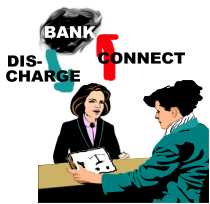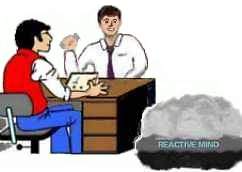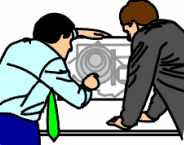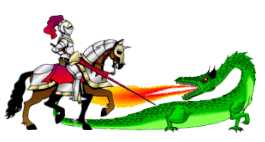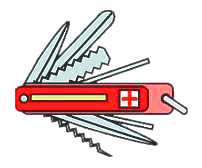|

A student usually studies something to increase his
or her understanding and knowledge about a subject. This is quite
elementary. If we have a young woman, Jane, and she doesn't know anything
about fine cooking and she needs or wants to know something about it, she
will get herself a cookbook and start to read recipes. When she has done
that for a while she will be ready to go out and buy some groceries and
try to make some of the dishes the cookbook describes. It is also possible
her mother will teach her to cook some fine meals and they will go through
this together. Both these ways would be informal, of course. No exams to
pass. No formal school to attend.
 |
To gain understanding
one needs to study
or read about it.
|
But let's say Jane wanted to become a nurse. She
would realize she didn't know much about nursing, patients, medication,
hospitals, and so on. She would soon realize that she would have to go to
school for several years to learn it all. Jane would have to understand
the subjects she was taught to obtain the needed information so she could
actually practice as a nurse. She would of course also have to pass her
exams in all the required subjects in order to get her certificate and to
be able to get a job as a nurse.
 |
There are a lot of skills and
special knowledge needed
to become a certified nurse.
|
Whether it is done formally or informally, learning
is a process by which you increase your understanding, knowledge, and
familiarity with a subject. Understanding plays an important and central
role. If Jane was unable to understand any of the information she was
taught in nursing school, she would flunk exams and leave the school. If
she couldn't read and understand the concept of cooking from the cookbook
she would be lost in this subject as well.
It is thus of great interest to any student, (and
we are all students in the school of life), to know what understanding is
and how to increase it.
Anatomy of Understanding
The interesting fact here is, that there is something to understand about
Understanding itself. It is composed of certain elements. You may have
thought of "Understanding" as something that needed no
explanation or wasn't possible to analyze. But the interesting fact is,
that it is composed of three elements. By understanding these three
elements we will understand the idea of Understanding itself
better.
The three elements are Affinity, Reality and
Communication.
Affinity means degree of liking of something
or somebody.
Reality has to do with experiencing objective things, recognizing
things that are, and also agreement with others.
Communication is the exchange of ideas and viewpoints.
These definitions are further explained below.
These three elements can be seen to be joined
together in a triangle. There are always the three of them. They influence
each other no matter which one you work on. Let's give some examples from
life. Later we will give some examples related to study.
Example 1: You talk to someone about the weather;
that's communication. You come to an agreement that this summer isn't
really worth remembering. Agreement; that's a reality as we define it.
You begin to think he's a great guy. That affinity is the first step to a
better understanding, a beginning friendship.
Example 2: You ask your neighbor's little son, who
is very shy, about his new bike. You ask him something that is very real
to him - reality. He'll bubble over with pride and excitement about it;
that's communication. You tell him you wished you had a bike like his when
you were his age; that's agreement/reality. He'll like you better from now
on and be less shy; that's affinity.
Example 3: You pat your dog - expressing affinity.
He'll jump up and bark at you playfully; that's one way dogs communicate.
You pick up the idea from him and take him for a walk; you establish a
reality with your dog.
This, then, is the ARC triangle. By increasing or
decreasing each or any of these points of the ARC triangle you can
increase or reduce understanding. It all depends on your intentions. The
relationship between A (affinity), R (reality) and C
(communication) is the anatomy of understanding.
Understanding, then, consists of A, R and C.
Affecting one element in a positive direction will cause the two other
elements to move in a positive direction as well. The results would be
higher or better understanding. A drop in any of the elements A, R or C
will cause a drop in understanding.
Let us look at the definitions of A and R and C
separately and add some more depth to them.
 |
Affinity
means degree of liking
somebody or something. When
you are closely connected to
someone you have high
affinity for
that person.
|
Affinity
Affinity is defined in terms of reaching or distance. One reaches
for something in order to have it close to one. Lack of affinity would be
expressed as a withdrawal.
Affinity is a phenomenon involving space. It
expresses the willingness to occupy the same space as the thing which is
loved or liked.
The reverse of it would be anti-pathy (dislike)...
which would be the unwillingness to occupy the same space as or the
unwillingness to approach something or someone.
It follows that the "mental space" of
someone widens with the number of things or people he loves. It follows as
well that someone with a lot of affinity finds it easy to include a lot of
things and people in his space. He manages to look at life from other
viewpoints as well as his own. That's a true sign of affinity. He is able
"to put himself in someone else's shoes" and look at things from
their point of view.
Put in more technical terms: he can assume the
beingness
of another; the other person's role or identity.
This doesn't refer to people only but to all
things, alive or dead (matter), such as plants and stones. Given enough
affinity, you can deliberately "become them". You can apply
'intuition', multiple viewpoints and imagination to achieve that.
Usually you have your viewpoint stably anchored
inside your head.
Yet, some people have the ability to put a
viewpoint into a withering plant on the table and "wander around
inside it" to find out what's wrong with it. They have for a moment
assumed the beingness of this plant.
 |
Reality
has to do with
Agreement. When something
is witnessed and signed it is
more real - also in
the eyes of the Law.
|
Reality
Reality is not looked at as something "objective" in our
definition.
It is certainly observable but not necessarily objective.
Each observer of a situation takes his own viewpoint when observing it.
This is true in two ways:
a) Mentally speaking: he sees things through the
filter of his own attitudes and considerations, and by the amount of
affinity he happens to have at the time. (Someone, who is sad or angry
makes a bad observer.)
b) Physically speaking: each observer stands in a
different location from the other and therefore has a different angle of
view. Therefore each observation, to start with, exists for each observer
individually only. This we call an actuality.
As soon as the observers share their
observations and come to an agreement with each other there is
"reality" in the full sense of the word:
An actuality can exist for one individually, but when it is agreed with
by others it can then be said to be a reality.
This does not exclude that you might disagree with
yourself occasionally. Off and on "one doesn't trust one's own
eyes", as we all know. So even for oneself you sometimes have to work
out what is real and what isn't.
Reality-changes can easily be brought about by
drugs and hypnosis, also by physical threats and violence. An individual's
own reality can be beaten out of him so he agrees with the agressor. He
will agree with you because he wants to live. This
way robots are made. In any case, when we talk about reality we talk about
agreement.
Reality is the agreement of perceptions and data in
the physical universe. (All we can be sure is real is that on which we
have agreed is real. Agreement is the essence of reality.)
Just because a few people have agreed on something
does not necessarily mean that it is "truly so". Who
would determine that anyway?
Ask some other people and you're bound to find a
different agreement on the same matter. Reality
is therefore: the agreed-upon apparency of
existence.
 |
Communication
is the
exchange of ideas and
viewpoints
over a distance.
|
Communication
Communication is the exchange of ideas between
two points or terminals. It can be between two living beings or between
the physical universe and a being -- this last we usually call perception.
Simply put, by perceiving and sensing something you
are already involved with communication and, thereby, with the ARC
triangle.
The perceptions, such as sight, sound, smell,
taste, are real to the extent that one can agree to them or not.
The use of the term "exchange" above
shows that there are two terminals involved in a communication.
"Terminal" means in our language "the end point of a
communication line". It can be a person or a thing.
There are two end points or terminals (typically
persons) in a communication: a source-point and a receipt-point.
The communication formula
Communication is: Cause, distance,
effect, with intention, attention, duplication and understanding.
 |
|
 |
Cause
(Source-point) |
<Distance> |
Effect
(Receipt-point)
|
|
Comm Formula:
The speaker is at Cause.
She communicates with Intention.
The listener is at Effect.
He listens with Attention
in order to Duplicate and Understand what she says.
|
With the above, one important
aspect of a study situation has been described: the student makes himself
receipt-point of the data and particles of the subject - typically coming
from a teacher or textbook writer. In case of printed information
the author is 'Cause' the book is the particle carrying the message and
the student is 'Effect'. He or she duplicates and understands the
information contained in the communication until it has been fully
included in her space (see illustration below). Now she really understands
it. She will master the data to the point she has ARC for them. They are
to some degree real to her, Reality. She can be around these data and
occupy the viewpoint they express, Affinity. She can communicate about
these data, such as discuss them or relay them, Communication.
|
|
Comm Formula:
A book carries the message from the author. Since the book is a
'dead' object the student uses ARC to get the Intention. She
still uses Attention in order to Duplicate and Understand.
|
When observing the ARC triangle in life and
study, one finds it usually works in the reverse order: Communication,
Reality, Affinity. Communication is the dominant part and "the easy
way in".
The reason for this is, that the
communication formula: Cause, distance, effect with duplication and
understanding can be seen to have all the elements of ARC. The affinity
part is overcoming the distance and the reality part is the amount of
duplication taking place. It results in greater understanding when
successful. If not successful it results in lowered understanding. The
simple action of communicating causes therefore an increase or decrease in
ARC.
This is how it works in study:
1. The student goes into communication with the subject by permitting
himself to perceive it.
2. He duplicates its reality until he can agree with the thing being this
way and no other.
3. He includes it in his space and thinking and can understand the reality
and point of view expressed.
As the student progresses through a study
he regains more and more certainty about what he learns and therefore
becomes more relaxed and cheerful about it.
We here assume the subject studied is free
of falsehoods, is useful, and worthwhile.
As the student has advanced through a
longer study he should be able to learn related data faster and faster and
often grasp new concepts even without having to read or hear it all. This
indicates a heightened affinity; an increased ability to occupy the
teacher's or the textbook writer's viewpoint.
 |
A student with high ARC
for a subject will understand
new data at one glance.
|
No drawn-out or tedious communication is
needed. No need to look at it this way and that way until finally the
whole thing can be partially understood. No! It's one glance at the data
and she has got it. Let's illustrate ARC and study with some examples:
Example: A green student is trying
to learn to become a mechanic. When he is first thrown into it the teacher
uses a lot of new words. Communication is completely cut. The
communication formula states: Cause, distance, effect, with
intention, attention, duplication and understanding. The student has no
duplication nor understanding as he doesn't know what the teacher is
talking about. He hasn't been around motors and can't agree or disagree
with anything shown. He is completely incapable of "thinking like a
motor", meaning mentally occupying the same space as the motor, and
thus having a feel for what he is being taught. His ARC is at the bottom.
If the teacher knows his business he will let the student look at
different motor parts and name them for him. Then have him touch
them and lift them. This gives the student some reality. The teacher will
tell him the function of each part is. That makes duplication and
understanding possible. Actual communication is being established. By
holding onto, lifting, fitting together these parts the student will
little by little loose his back-off and fear of these motor parts and feel
relaxed and quite cheerful about the whole thing. His affinity will come
up.
Example: A master mechanic who has
repaired motors for years can just by listening to a motor tell exactly
what is wrong or exactly what three things to look for. Through reading
about it (communication) and repairing a lot of cars he has gotten
experience (reality) and is completely capable of "being the
motor" (affinity). He can feel any bad performance of the motor as a
physical sensation as if it was happening to his own body. When he hears
the motor going 'clank, clank' it is painful to him. When it purrs like a
cat it is a great pleasure to him. Obviously he has high affinity for
motors and high ARC = Understanding for motors.
|


